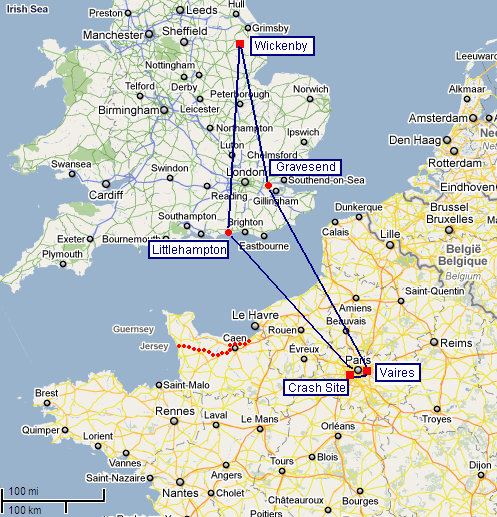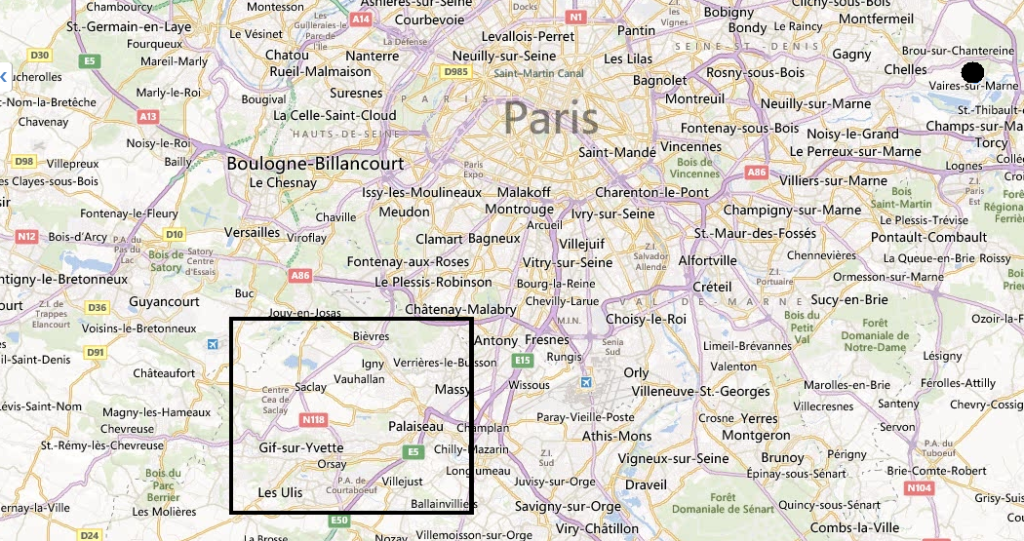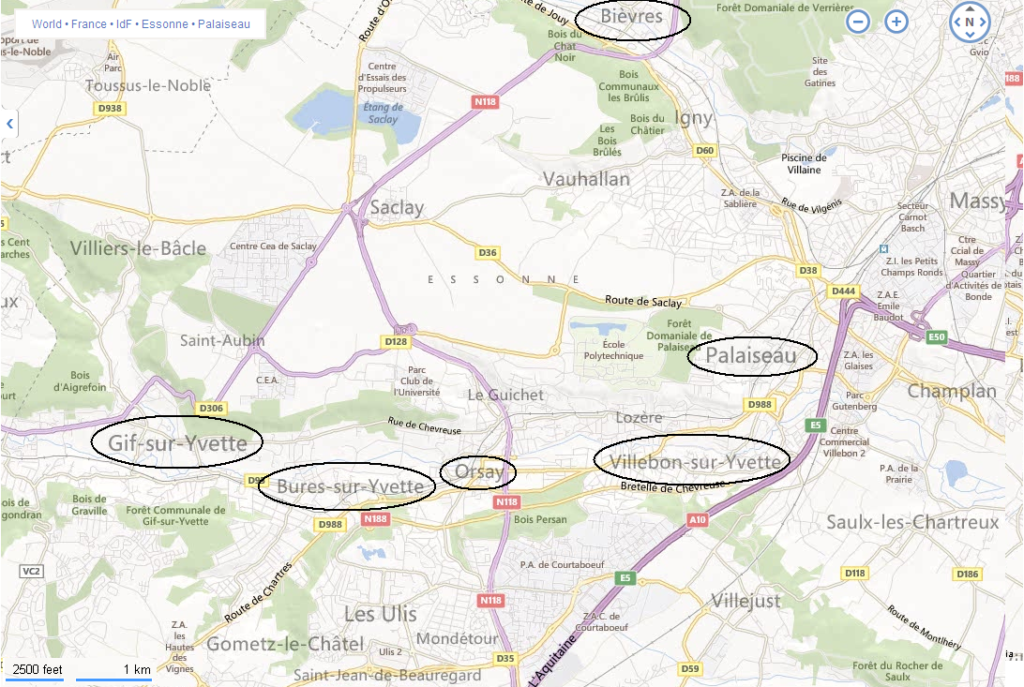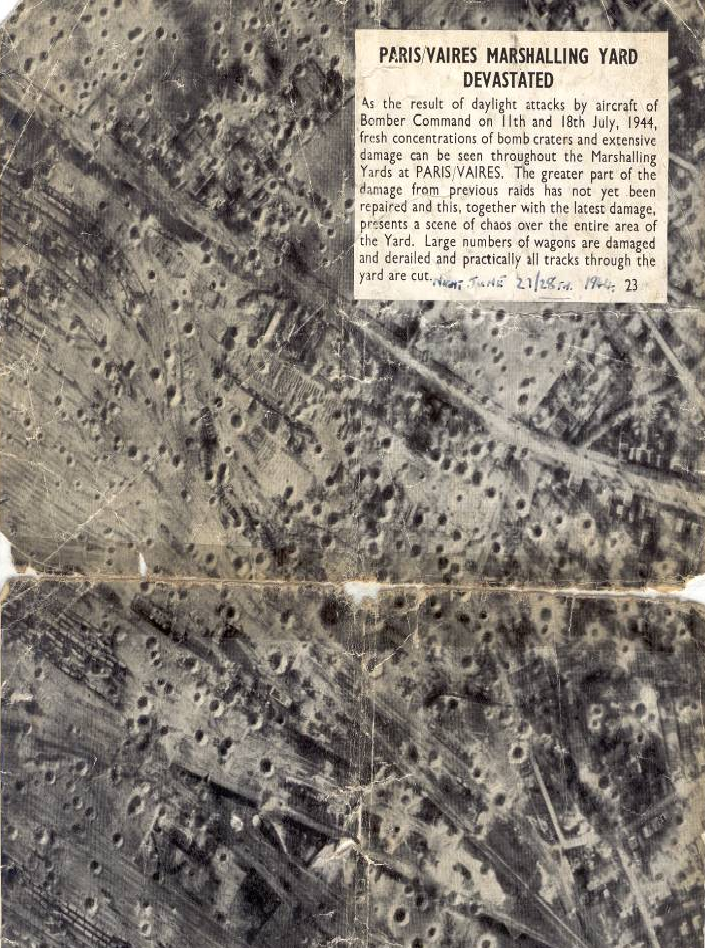Vaires-sur-Marne
This mission was their 17th operation as a crew and was just past the halfway point of their standard Bomber Command tour of 30 operations. It was a night time bombing raid on the Paris/Vaires railway marshalling yards at Vaires-sur-Marne on the eastern outskirts of Paris on the night of 27/28 June 1944. Vaires is on the railway line between Paris and the eastern city of Strasbourg on the bank of the river Rhine with direct rail links across the river into the heart of Germany. This strategic line would have been used to transport men, armour and munitions to support German attacks on the Allied forces trying to break out of Normandy, just three weeks after D-Day.
Lancaster ND424 took off from Wickenby at 00:29 on the morning of Wednesday 28 June 1944. The planned route to the target was:
- Wickenby (5000N 0030E) in Lincolnshire.
- Gravesend (4918N 0218E) in Kent.
- Vaires (4842N 0238E).
The planned route home was:
- Vaires (4842N 0238E).
- Littlehampton (4847N 0128E) in Sussex.
- Wickenby (5000N 0030E) in Lincolnshire.

The total distance from Wickenby to Vaires and return via the route points above is around 710 miles (340 miles to the target and 370 miles back). These are just straight line estimates and exclude forming up and other possible tactical diversions.
Lancaster ND424 dropped its bombs as planned between 03:00 and 03:06 (2.5 hours after take-off) but it had suffered critical engine problems during the final part of the journey to the target. While over the target they were hit by flak and with only one engine remaining they were losing height rapidly. The navigator assessed the situation and said they would not be able to make it back home, so the pilot gave the order to abandon aircraft. All seven crew bailed out and parachuted to the ground safely in various locations to the south west of Paris.B

The places listed below are not necessarily where the crew landed but are names mentioned after they had walked some distance.
- Les Faircloth: Gif-sur-Yvette.
- Doug Jordin: Gif-sur-Yvette, close to Les.
- John Stephen: Villebon-sur-Yvette then Bures-sur-Yvette.
- Bob Yates: Orsay.
- Joe Sonshine: Palaiseau (“7 or 8 miles south west of”).
- David Davies: Bievres.
- Mike Guilfoyle: Gif-sur-Yvette, where he met Doug and hid in a cottage.

So far it is not been possible to deduce in what order the crew abandoned the aircraft. According to the crash report David may have been the last man out, preceded by Mike. Doug confirmed during a BBC interview at their reunion in 2008 that Les pushed him out of the aircraft. Les and Doug were the furthest south-west of the known locations so they may have been last out. As can be seen from the drop locations, the aircraft was heading in a south-westerly direction and crashed around 26 to 28 miles from the target in the area around Gif and Chevreuse.
Four of the crew evaded capture and eventually returned home safely:
- Bomb Aimer John Stephen.
- Wireless Operator Bob Yates.
- Flight Engineer David Davies.
- Mid Upper Gunner Leslie Faircloth.
Three were captured and became prisoners of war:
- Pilot Mike Guilfoyle.
- Navigator Joe Sonshine.
- Rear Gunner Doug Jordin.
The Damage Done
Following a raid the RAF would send fast photo-reconnaissance aircraft over the target to take photographs. These were used to assess the damage done and to decide if further raids were required. Below is Leslie’s original newspaper cutting from the period showing the Paris/Vaires marshalling yard just three weeks after ND424’s final operation. It reads:
PARIS/VAIRES MARSHALLING YARD DEVASTATED
As the result of daylight attacks by aircraft of Bomber Command on 11th and 18th July 1944, fresh concentrations of bomb craters and extensive damage can be seen throughout the Marshalling Yards at Paris/Vaires. The greater part of the damage from previous raids has not yet been repaired and this, together with the latest damage, presents a scene of chaos over the entire area of the Yard. Large numbers of wagons are damaged and derailed and practically all tracks through the yard are cut.

The High Cost
On D-Day and the following crucial weeks both the Germans and the Allies paid a very high price in human terms. During June, July and August of 1944, the Wehrmacht suffered nearly 240,000 casualties and another 200,000 men were captured by the Allies. The Allied 21st Army Group of British, Canadians and Poles sustained over 83,000 casualties and the Americans nearly 126,000.
During the same period the Allied air forces lost over 16,700 men killed and missing. During the course of the war Bomber Command lost over 55,000 airmen killed. The average age of their crews was just twenty-two.
Over 22,000 aircrew of all RAF commands were lost without trace and have no known graves, so they are commemorated at the Runnymede Memorial.
Of the 73 Lancasters in the ‘ND400’ production range, 60 were lost (82%) and just 13 aircraft survived the war and were struck off charge (18%).
During the period from March to August 1944 12 Squadron lost 40 Lancasters and as a result, 280 crewmen were killed, captured or evaded in six months of operations.
During the 17 known operations in which ND424 and our crew took part 12 Squadron lost a total of 11 aircraft. Of the 78 airmen on these lost aircraft 51 were killed.
On these 17 operations Bomber Command lost 183 aircraft, an average of nearly 11 aircraft lost per night. This resulted in more than 1,280 airmen who were killed, captured or evaded in just under 2 months of 1944.
The figures above show that the odds were against the seven young men of ND424, but survive they did. Unfortunately, as a result Les, Doug, Bob and Joe all sustained injuries that would affect them in later life
The bravery of these seven young men is beyond question and I feel it is vitally important that their stories are recorded and not forgotten.
